3 April 2023
The Martian atmosphere is a fascinating and enigmatic subject of study. It is a complex system of gases, dust, ice, and other particles that are constantly interacting and affecting the planet's weather patterns. However, this highly technical and scientific data is often unapproachable to a wider audience, which raises the question, how can abstruse, scientific data about the atmosphere of Mars be represented in an artistic and appealing form?
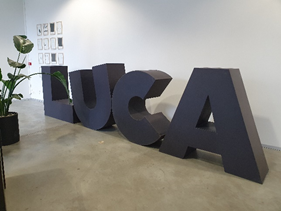 Inspiring collaboration between BIRA-IASB and LUCA School of Arts in the framework of the RoadMap project. Credits: Karolien Lefever (BIRA-IASB) Inspiring collaboration between BIRA-IASB and LUCA School of Arts in the framework of the RoadMap project. Credits: Karolien Lefever (BIRA-IASB) |
Inspired and informed by researchers from the Royal Belgian Institute for Space Aeronomy (BIRA-IASB) studying the atmosphere of Mars, students from the Media and Information Design (MIND) programme of Luca School of Arts in Brussels sought to answer this question in the course of a week-long workshop on artistic data visualization, that took place from 27-31 March 2023. Under the guidance of Gijs Ipers and Jakub Stepanovix, highly complex data about dust and ice in the atmosphere were transformed into unique and engaging representations that offer a new way of looking at scientific research. The results were presented during an exhibition at the LUCApremises on 31 March. |
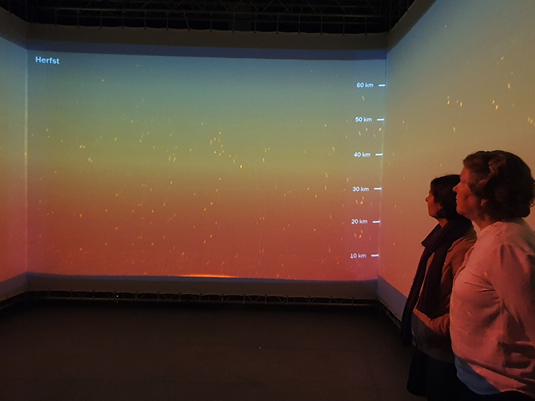
Digital projection "Dust on Mars". Scientists from the Royal Belgian Institute for Space Aeronomy are being immersed in an environmental representation of aerosols in the Martian atmosphere during the LUCA project week exhibition. Creation by: Hannelore Knaepen, Asad Masood, Lisa Muylaert and Tristan Van Garsse. Picture credits: Karolien Lefever (BIRA-IASB) |
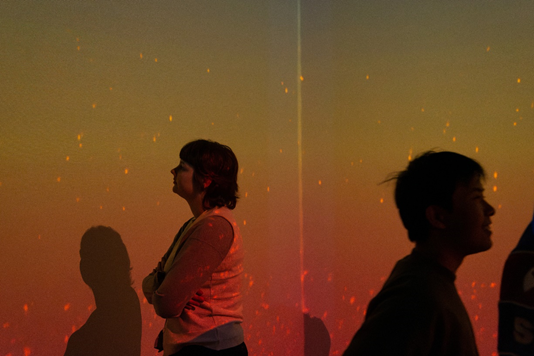 Students are discovering the installation “Dust on Mars”. Picture credits: Gijs Ipers (LUCA School of Arts) Students are discovering the installation “Dust on Mars”. Picture credits: Gijs Ipers (LUCA School of Arts) |
|
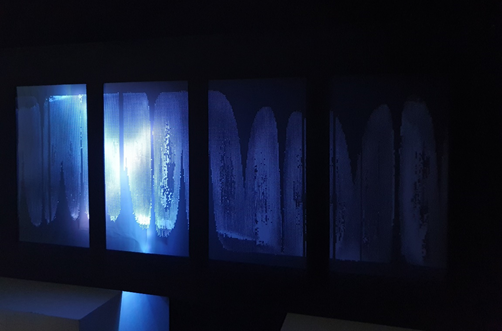 Depending on the amount of dust and ice clouds present in the Martian atmosphere, there may be less light reaching the planet's surface. “Shine through Mars” is an installation where we can see the amount of light that reaches Mars, based on the data collected by the Royal Belgian Institute for Space Aeronomy throughout the four seasons of one year. Creation by: Houda Ben Azzouz, Romain Couet, Fien Denblinden and Federica Garcia Carrero. Picture credits: Karolien Lefever (BIRA-IASB) Depending on the amount of dust and ice clouds present in the Martian atmosphere, there may be less light reaching the planet's surface. “Shine through Mars” is an installation where we can see the amount of light that reaches Mars, based on the data collected by the Royal Belgian Institute for Space Aeronomy throughout the four seasons of one year. Creation by: Houda Ben Azzouz, Romain Couet, Fien Denblinden and Federica Garcia Carrero. Picture credits: Karolien Lefever (BIRA-IASB) |
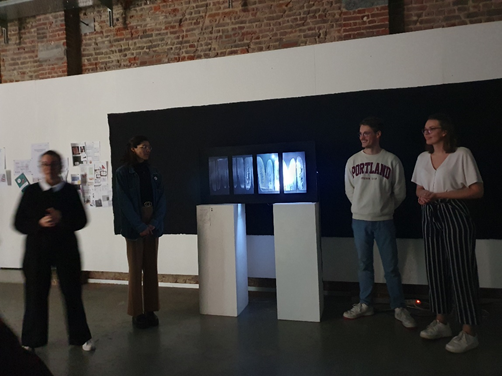 Students are discovering the installation “Dust on Mars”. Picture credits: Gijs Ipers (LUCA School of Arts) Students are discovering the installation “Dust on Mars”. Picture credits: Gijs Ipers (LUCA School of Arts) |
|
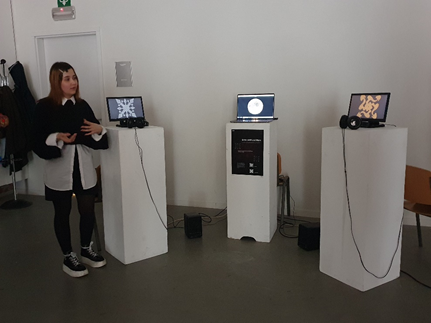 “Ice Clouds and Dust on The Red Planet: An Acoustic Journey” is a sonic experience that explores the changing amounts of dust and ice clouds in the Martian atmosphere. Each of these two particles has a unique sound (left: ice clouds, right: dust), while the frequency of the sound represents the amount of that particle. Both sounds are combined into one single representative sound (middle). As time progresses the seasons change, resulting in a unique acoustic representation of the changing weather patterns on Mars. Creation by: Karina Gevorgyan, Nattakit Pheanklang and Dieter Roozeleer. Picture credits: Karolien Lefever (BIRA-IASB) “Ice Clouds and Dust on The Red Planet: An Acoustic Journey” is a sonic experience that explores the changing amounts of dust and ice clouds in the Martian atmosphere. Each of these two particles has a unique sound (left: ice clouds, right: dust), while the frequency of the sound represents the amount of that particle. Both sounds are combined into one single representative sound (middle). As time progresses the seasons change, resulting in a unique acoustic representation of the changing weather patterns on Mars. Creation by: Karina Gevorgyan, Nattakit Pheanklang and Dieter Roozeleer. Picture credits: Karolien Lefever (BIRA-IASB) |
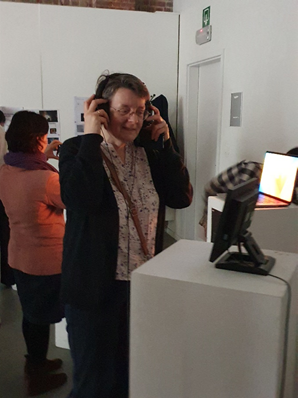 Ann Carine Vandaele, the RoadMap project coordinator, is listening to the sonic experience “Ice Clouds and Dust on The Red Planet: An Acoustic Journey”. Picture credit: Karolien Lefever (BIRA-IASB) Ann Carine Vandaele, the RoadMap project coordinator, is listening to the sonic experience “Ice Clouds and Dust on The Red Planet: An Acoustic Journey”. Picture credit: Karolien Lefever (BIRA-IASB) |